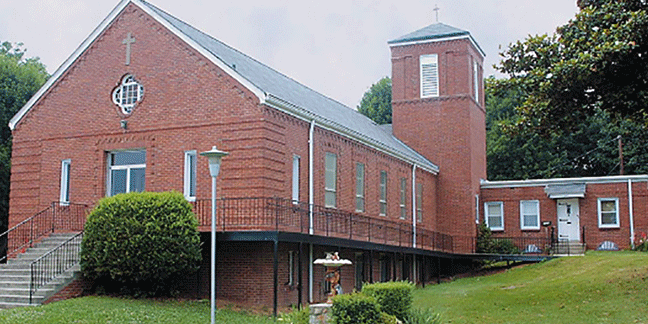 WINSTON-SALEM — St. Benedict the Moor Church celebrates its 80th year this month, and is sharing the following historical information with parishioners in lieu of an in-person event due to COVID-19 restrictions:
WINSTON-SALEM — St. Benedict the Moor Church celebrates its 80th year this month, and is sharing the following historical information with parishioners in lieu of an in-person event due to COVID-19 restrictions:
On Sunday morning Nov. 24, 1940, the first Mass for the community that would become St. Benedict the Moor Parish was celebrated inside a new local funeral home.
The A. Robinson Building was built on Patterson Avenue in 1940-1941 as the Howard-Robinson Funeral Home, an African American business. The Robinson building and the funeral home it housed tell the story of the increasingly prosperous African American community in Winston-Salem at that time. The building, now listed on the National Register of Historic Places, offered a place for the Black Catholic congregation to meet instead of its former meeting place, at the home of local lawyer Hosea V. Price.
The parish was erected by Raleigh Bishop Eugene McGuinness and placed under the direction of the Order of Friars Minor (better known as the Franciscans), with the mission to serve Black Catholics living in the East Winston community and to share the richness of the Catholic faith with the Black community. Father Ronald Scott, O.F.M., the founding pastor, was a pioneer missioner among the African American people in the South from 1933 to 1945 and built three churches in North and South Carolina.
The church was named in honor of St. Benedict the Moor, a Franciscan friar who lived a holy life of prayer and charity and is the patron saint of African Americans.
Mr. and Mrs. Price, and approximately 11 other black Catholics living in the Winston-Salem area, assisted Father Scott in establishing the parish community. Before Father Scott’s arrival, the Prices had hosted local Black Catholics for meetings and prayer in their home. During the Jim Crow era in many places, including some Catholic churches, African Americans were segregated from white parishioners, seated separately at the back of a church or in the loft away from white parishioners. However, if 11 or more African Americans attended white parishes, a separate church was typically built to accommodate the increasing number of parishioners.
On April 26, 1940, property for a church, parish hall and rectory was bought from the estate of Bishop Kyles of the A.M.E. Zion Church. The property purchased was located at Twelfth Street and Hattie Avenue, the present site of the church and rectory. Bishop McGuinness dedicated the church on Sept. 7, 1941.
Early inscriptions in the parish’s baptismal registry include the family names: Ellis, Guest, Maxwell, Pledge, Crew, Baltimore, Wellman, Grier, Bitting, Scales, Tucker, Jones and Barons. After eight years, the number of parishioners had risen to more than 100.
During those early years, parish societies offering spiritual and social enrichment were formed: The Legion of Mary, Third Order of St. Francis, St. Monica’s Ladies Guild and the St. Benedict’s Men’s Club. Together they formed the core group of men and women sharing in the life of the Church. Altar boys were trained to assist at the Holy Sacrifice of the Mass and a choir was formed to add to the solemnity of the sacred rites.
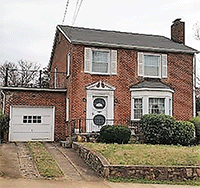

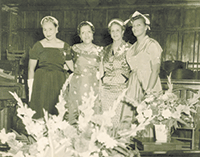
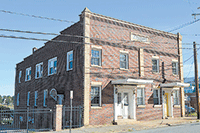 Responding to the parish’s need to enhance faith formation and education, the Sisters of St. Francis of Allegany, N.Y., arrived in Winston-Salem to open an academy. They purchased property at the corner of 14th Street and Hattie Avenue and began preparing the buildings to serve as classrooms and dormitories. On Sept. 7, 1946, St. Anne’s Academy was opened. Raleigh Bishop
Responding to the parish’s need to enhance faith formation and education, the Sisters of St. Francis of Allegany, N.Y., arrived in Winston-Salem to open an academy. They purchased property at the corner of 14th Street and Hattie Avenue and began preparing the buildings to serve as classrooms and dormitories. On Sept. 7, 1946, St. Anne’s Academy was opened. Raleigh Bishop
Vincent Waters dedicated the academy, convent and the residence for the girls on Sept. 29, 1946.
In September 1950 under the direction of the Franciscan Sisters, St. Benedict Grammar School was opened with 116 students. By 1958, 250 students were enrolled in a program that worked toward academic excellence in an environment that called them to a Christian way of life. Parishioners and neighbors recall the beautiful May processions, plays, carnivals and championship basketball teams of the 1950s, ’60s and ’70s. The school closed in 1979 because of dwindling enrollment and the rising cost of offering a quality education.
In 1969 St. Benedict the Moor assumed responsibility for its first mission: Our Lady of Fatima Chapel was opened in downtown Winston-Salem as a “chapel of ease.” The chapel is now a mission of Our Lady of Mercy Church in Winston-Salem.
In 1970 Catholics to the east in Kernersville became the second mission of St. Benedict the Moor until 1973, when it was raised to the status of a parish and became Holy Cross Church.
In August 1987, Jesuit Father Thomas Gaunt was named pastor of St. Benedict the Moor Church in Winston-Salem and its mission, Good Shepherd in King.
In 1990 the parish established a “migrant ministry” to support the growing number of Hispanic Catholics in the community, many of whom worked on Yadkin County’s tobacco farms and agricultural operations. The church gave out food and clothing to the families and assisted them with immigration documentation and legal aid. In 1999 the first Mass was celebrated for the Latino community by Father Larry Hunt.
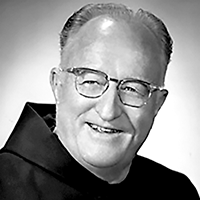 The parish has always been committed to serving the community. When St. Anne’s Academy and St. Benedict Grammar School closed, the facilities were retooled to provide services to the community. The Kyle Heights Apartments is on the former site of St. Anne’s Academy and Convent and the St. Benedict Grammar School became the Franciscans Day Care Center.
The parish has always been committed to serving the community. When St. Anne’s Academy and St. Benedict Grammar School closed, the facilities were retooled to provide services to the community. The Kyle Heights Apartments is on the former site of St. Anne’s Academy and Convent and the St. Benedict Grammar School became the Franciscans Day Care Center.
The St. Benedict the Moor Resurrection Summer Day Camp partnered with St. Stephen’s Episcopal and Dellabrook Presbyterian to offer a four- to five-week summer program for children who otherwise would not have positive activities during the summer months.
In the summer of 2004, the Community Knowledge Center was established at the church. Sponsored by Winston-Salem State University, it offered classes for senior citizens, tutoring for middle school students and income tax service for the Hispanic community.
The parish also placed a high commitment on volunteering with its Crisis Control Ministry, Red Cross Donor Program, Samaritan Soup Kitchen, Narcotic Anonymous and Community Watch Meetings, Food Pantry and Computer Lab.
As we look back and reflect on our 80-year faith journey, we must stop and give thanks for the many blessings bestowed on each of us and our parish. Those blessings began with the determination of a small group of faithful Black Catholics whose goal was to gather for worship and to share the Gospel with their community. We look forward to all that God has in store for our parish in the future as we continue to proclaim the Good News and as we look to Him for wisdom and guidance.
— Gloria Wilson, Special to the Catholic News Herald. Gloria Wilson is co-chair of the St. Benedict the Moor Catholic Church History Committee, which also includes Betty Alexander (chair), Syveria Hauser, Alice Gambrell, John Jones, Lois Jones and Gerald McKoy.


